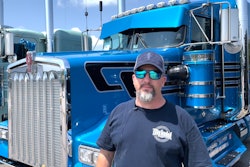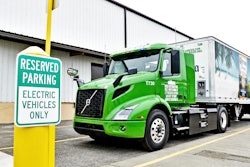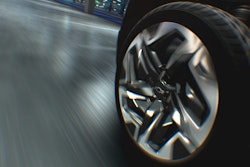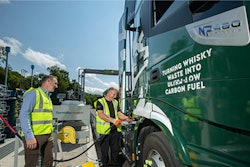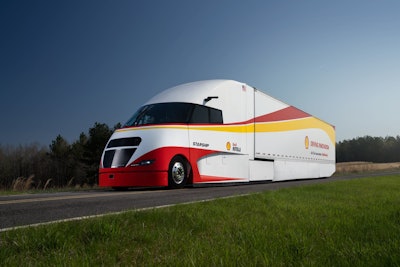
The long-haul truck of tomorrow is powered by diesel today.
Let that sink in a moment.
There’s no question that Shell had options when it came to powering their Starship 2.0 which recently completed a cross-country trip to demonstrate available technologies that best maximize energy efficiency while reducing emissions in a Class 8 truck.
They could have opted for a hybrid drivetrain. In fact, after their first Starship (Shell refers to it now as Starship 1) completed a run across the U.S. in 2018 they made it clear that they were talking with Hyliion, and so it looked as though they were leaning towards a hybrid for Starship 2.0. After all, who doesn’t want to capture energy that would otherwise be wasted?
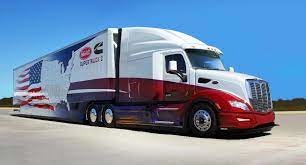 Diesel's not dead by a long shot. The Department of Energy recently announced 55% brake thermal efficiency in DOE SuperTruck II. The Cummins-equipped Peterbilt features a waste heat recovery system, "an important metric in the SuperTruck II program," according to Cummins.Department of Energy
Diesel's not dead by a long shot. The Department of Energy recently announced 55% brake thermal efficiency in DOE SuperTruck II. The Cummins-equipped Peterbilt features a waste heat recovery system, "an important metric in the SuperTruck II program," according to Cummins.Department of Energy
“So if you can capture that energy through a regenerating axle into batteries, then sometime later you can reuse that battery energy to propel the vehicle,” Mainwairing continued.
But then in the world of long-haul fuel efficiency where splitting hairs over performance characteristics can add up to important efficiency gains, particularly over thousands of miles, Shell demurred. The reason? Hyliion’s system, like other hybrid powertrains, introduces additional weight which is okay for some applications, just not for long-haul, Shell decided.
“When you start to reflect on that, the (Hyliion) axle itself is quite massive,” Mainwairing said. “So if you introduce that, it adds weight to the tractor and that's then cargo that you can't carry.
“And if you do a sort of back-of-the-envelope calculation about the balance of energy savings that comes from the actual regenerating versus the displaced cargo and the effect that has on the freight ton efficiency, what you'll find is for the sort of trans-American journey we were doing is that energy wise, you're actually much better off to carry more cargo than you are to try and regenerate,” Mainwairing said.
It's not just the axle, but the extra battery weight too. So what about solid-state which is expected to enter the passenger car market in the mid-2020s? Much progress has been made on those next-gen batteries which are roughly half the weight with nearly twice the energy density of conventional lithium-ion. Might they be a good fit for long-haul?
[Related: Electric car analyst favors clean diesel in Class 8 trucks]
“I think that's a very difficult question to answer, with confidence anyway,” Mainwairing said. “I completely agree with you that progress is being made. But we're still in this weird position that the batteries do weigh a lot. So again, like the axle they're displacing cargo weight.
“There's the ease of use aspect as well. To charge batteries of what might be 650 kilowatt hours up quickly you need megawatt scale power to actually put the electrical energy in. So the ubiquity of diesel fuel is really, really strong. Again, I'm not advocating, long-term sticking with diesel as such, but it is convenient and when running it in Starship it’s actually exceptionally energy efficient. That doesn't mean we're not interested in batteries. Of course we are. But again, I suspect those are more allied to short-scale city driving, maybe for last-mile delivery.”
Diesel here ‘for a good long time’
Starship 2.0 uses a 2020 Cummins X15 400 EX Efficiency Series engine paired up with a 12-speed Eaton Endurant transmission. When asked about a future powertrain for Starship, hydrogen came up as a possibility though the current fueling infrastructure is so lacking that it can’t support trucking in the U.S. beyond California. The rest of the world isn’t much better.
“We’ll need an infrastructure change in all countries in the world to convey the hydrogen to the vehicle,” Mainwairing said. “But either as a fuel cell vehicle, or maybe as a hydrogen engine vehicle, we feel that it’s much more ubiquitous and consistent with long haul freight.
“So while we were encouraged by the battery bit, I don't think it's there yet,” Mainwairing continued. “And part of me thinks that for long haul freight, it will never actually be there. I'll happily eat my hat if I turn out to be wrong, but on that sort of timescale of 30 years, I'm actually pretty skeptical that it actually ends up being the more energy efficient truck transport mechanism.”
[Related: West Coast fleets favor renewable diesel but concerned about short supply]
Diesel’s making strides in other major tests. Allen Schaeffer, executive director at the Diesel Technology Forum, noted how the SuperTruck program—a partnership of the Department of Energy, truck and engine OEMs—exceeded the 55% brake thermal efficiency with a Cummins diesel.
 Shell will soon be revealing the results of their recent 2,300-mile trip from San Diego to Jacksonville, Fla. “We’re very pleased,” said Bob Mainwairing, Shell’s technology and innovation manager.Shell
Shell will soon be revealing the results of their recent 2,300-mile trip from San Diego to Jacksonville, Fla. “We’re very pleased,” said Bob Mainwairing, Shell’s technology and innovation manager.Shell
Both Mainwairing and Schaeffer support alternative fuels. In keeping with its goal of becoming a net-zero energy company by 2050, Shell continues to expand its alt fuel portfolio which includes natural gas, biofuels, hydrogen, solar, wind and charging stations.
Like Mainwairing, Schaeffer welcomes alternative fuels for their ability to cut carbon and improve air quality but noted that there’s plenty of work to be done.
“For BEVs, there is the issue that in the U.S. today about a third of the electricity generated comes from natural gas, so they are not truly ZEV until all electricity is from renewable sources,” he said. “In the meantime, freight has to move, and truck and engine OEMs must serve their customers today. I think even as all the truck OEMs explore hydrogen or electric, they also concur that diesel is going to be around for a good long time in all these segments.”
Mainwairing is also impressed with diesel’s thermal efficiency gains and believes the fuel will be here for a good long time to come.
“In thinking of that 2050 target, and this time for materiality challenge, one of the mantras of what we're doing is being the best you can possibly be today in order to seed improvement at scale in the future,” he said.
The best fuel for long-haul today is diesel which includes its cleaner-burning siblings biodiesel and renewable diesel. Tomorrow it may be hydrogen but with only 48 stations in the U.S.—and all located in California, according to the Department of Energy—it’s going to be a long and costly wait.



